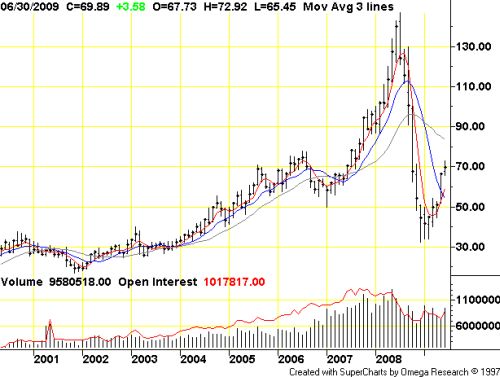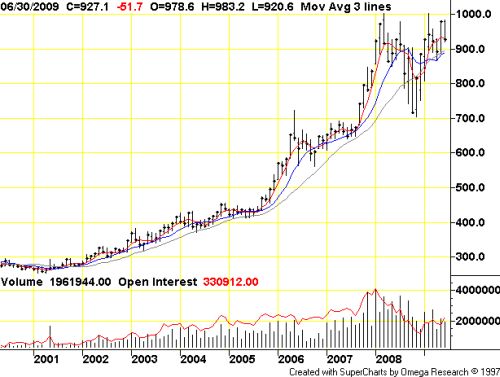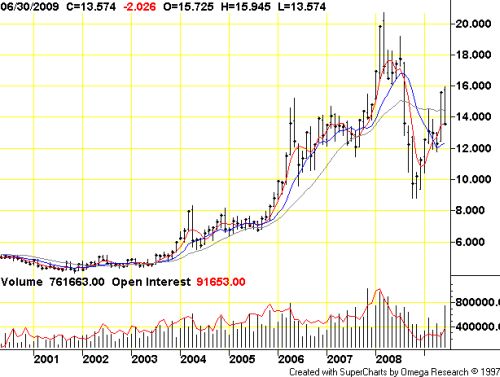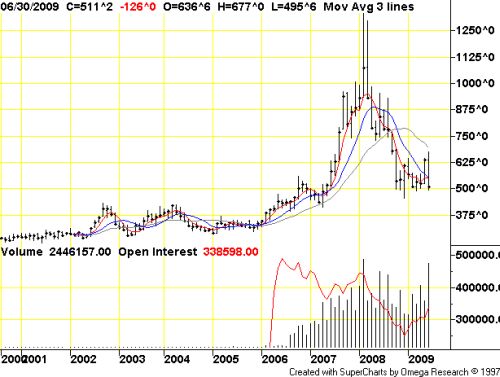Commodities | Jul 08 2009
By Greg Peel
“The first exchange-traded fund tracking the price of crude oil by investing in futures contracts is expected to begin trading on the London Stock Exchange on July 28, according to a press release by the fund’s backer, Oil Securities Limited. Two classes of the ETF are expected to be listed: one priced off the Brent Contract trading in London, and another based on the WTI (West Texas Intermediate) Contract traded in New York. ‘We anticipate that the listing will open up the oil market to a very broad range of investors,’ said Graham Tuckwell, chairman of Oil Securities Limited, in the release.”
And Tuckwell was absolutely right.
This is a Dow Jones report dated July 15, 2005. Prior to 2005, mutual funds and retail investors looking to invest in oil did so by buying the shares of oil producing companies. The volatile futures market was left as a preserve of actual oil producers and consumers looking to hedge their exposures, and to a handful of cowboy hedge funds and individual speculators who provided liquidity for such trades to occur. Futures were deemed too risky a proposition for mutual funds and too scary for most retail investors.
But with the introduction of exchange-traded funds, fund managers and retail investors alike were effectively introduced to a new investment asset class. Traded on the stock market, commodity ETFs provided a proxy for direct commodity investment. In 2005, China was on the move and commodity prices were on the way up. Direct commodity investment became a more direct means of hedging against inflation, and of speculating on now rapidly rising commodity prices. Oil, as one commodity, became the speculative plaything of hedge funds and retail investors and a mandatory asset class for pension funds. The once steady and relatively closed shop of oil trading was suddenly opened up to the herd.
Now take a look at a monthly chart of oil in the twenty-first century. Draw a line down the centre at mid-2005 and note how lack of much volatility on the left gives way to eventual extreme volatility on the right.

There you have it – herd mentality. While extreme movements between 2007 and today reflect the GFC path of the US dollar – from weakness to strength and back to weakness again – the blow-off top and blow-off bottom on the chart simply reflect the classic overshooting of speculative exuberance and speculative panic. Note the volume bars at the bottom of the chart. That’s Tuckwell’s “very broad range of investors”.
Were oil price movements exacerbated by the GFC? Or was the GFC exacerbated by oil price movements? Either way, US market regulators now want to put a stop to such violent and destructive commodity price volatility.
And oil is not the only culprit. The first (US) gold ETF was launched in late 2004:

Silver didn’t follow until 2006:

And while the first wheat ETF was launched in 2003, 2007 saw the launch of the first ETF on the world’s most popular commodity price index – the Reuters/CRB index – which has wheat as a component:

Indeed, by mid-2008 there were close to 700 different ETFs on any asset class you could imagine listed in the US. It is no great surprise that acceleration in such listings began around 2004, as that was when the Fed funds rate was dropped to a record low 1%. The lack of return available on traditional yield investments and the cheap funds available to invest in growth investments fuelled not only bubbles in property and stocks but in commodities as well. In the latter case, China provided the excuse.
So again, one might be attempted to explain away commodity price volatility in 2007-09 simply as a result of the greatest financial turmoil in decades, but one can quite easily argue the point the other way around.
Note that the oil price has just fallen 12% in a week. Its recent 125% rally from US$32 to US$72 has been the sharpest ever recorded, and the June quarter increase of 41% also the biggest move on record. What caused the rally? Easy: the US dollar began to weaken again under weight of debt, causing inflation fears; China began buying, providing misconceptions of real demand; and the higher the oil price rose, the greater the risk of inflation, and the greater the risk of inflation, the greater need for funds to hedge by buying oil, and the higher the oil price rose…Which all adds up to “speculative bubble” once again.
Dow Jones reports “passive” oil positions (ie speculative rather than industry) increased by 30% to 600m barrels from the end of 2008 to the end of June. Yet every week the level of total US crude inventories broke new records.
Regulators never anticipate volatile activity in financial markets, they only ever fuel it. The rapid growth of ETFs came with regulatory approval. There are even high-leverage ETFs and short-side ETFs, all which needed to meet with regulatory approval. But it is never the regulators fault, however, when everything goes awry. It is only ever the fault of those evil speculators. Once again, regulators are looking to clamp down, via new regulation, on that which they previously endorsed via regulatory lenience.
Regulators famously barrel along with their eyes in the rearview mirror and their feet planted firmly on the accelerator.
The US Commodity Futures Trading Commission has decided to hold a series of meetings over the northern summer to discuss the imposition of limits on exchange-traded fund and index fund investment. This time it’s not just recalcitrant hedge funds the CFTC is attempting to curb, but even supposedly staid investment funds such as California’s biggest public servant pension fund and the Harvard University endowment fund, both of which are examples of how even supposedly risk-averse managers can be swept up on the tide of hedging-cum-speculation.
There is no suggestion yet as to exactly how the CFTC plans to implement restrictions. One presumes that whatever is decided will go some way to reducing volatility extremes. But will this take the gloss off ETFs and commodity funds as an investment class?
Consider that for a long time, futures trading – including the very oil futures which are acquired by an ETF on behalf of the investor – have themselves been subject to restrictions such as individual open position size limits and intra-day price movement limits. These limits are tweaked every now and again at the CFTC’s discretion, or the discretion of the relevant exchange. Back in 2006, limits on Comex copper futures were suddenly reined in and the runaway rally halted.
Such limits didn’t seem to make much difference to oil futures in 2008-09. And where were the regulators then?

